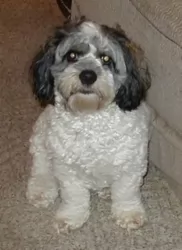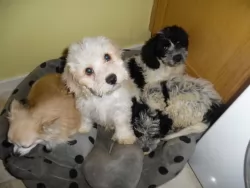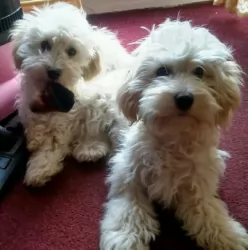 MyDogBreeds
MyDogBreedsCockachon is originated from United States but Cypro Kukur is originated from India. Cockachon may grow 51 cm / 20 inches shorter than Cypro Kukur. Cockachon may weigh 81 kg / 178 pounds lesser than Cypro Kukur. Cockachon may live 3 years more than Cypro Kukur. Both Cockachon and Cypro Kukur has almost same litter size. Both Cockachon and Cypro Kukur requires Low maintenance.
 The Cockachon is not a pure bred dog but rather a cross between the Cocker Spaniel and the Bichon Frise. Very little if anything is known about who initially developed the Cockachon. It is known that the International Designer Canine Association (IDCA)registered and recognized the hybrid in 2009.
The Cockachon is not a pure bred dog but rather a cross between the Cocker Spaniel and the Bichon Frise. Very little if anything is known about who initially developed the Cockachon. It is known that the International Designer Canine Association (IDCA)registered and recognized the hybrid in 2009.
It is obviously a relatively new cross breed. The hybrid is also recognized by the American Canine Hybrid Club (ACHC), International Designer Canine Registry (IDCR) and the Designer Dog Kennel Club (DDKC).
The Cypro Kukur is an ancient dog breed which originated in the Kumaon area of India. It is interesting to note that the name Cypro Kukur translates to Cyprus Dog, but the dog doesn’t appear to have originated in Cyprus.
The dog was used to guard livestock. It has a history that goes right back to about 300 years BC. The true history of this dog is shrouded in mystery and there are researchers who believe that foreign explorers to the Cyprus region imported these Kumaon watchdogs. There are those who believe the dog descended from the Molosser dog breeds.
The dog is also known as the Indian Mastiff or Kumaon Mastiff, but it is facing extinction with just a small number of pure Cypro Kukur remaining in the area. Today, however, there appears to be quite a large number of the dogs in Europe.
 The Cockachon is a cute, little dog very popular in current times. He is small, compact, dark eyes, a round head and black nose. He has a baby face and fluffy hair. It has a furry tail and a blunt muzzle.
The Cockachon is a cute, little dog very popular in current times. He is small, compact, dark eyes, a round head and black nose. He has a baby face and fluffy hair. It has a furry tail and a blunt muzzle.
The Cockachon is a mix between the American Cocker Spaniel and the Bichon Frise. In order to get a better idea of what the hybrid can look like just look at the individual parents. The American Cocker Spaniel is a small dog with a short muzzle and domed head. It is in the Sporting Group, but it is the smallest member of the group. He has a compact, sturdy body and though domed his head is refined.
The Cocker’s stance includes a sloping topline, muscular hindquarters and strong shorter legs adds up to a balanced canine. The coat can be in a wide variety of colors including liver, golden, black, and red. Also, it could be liver and tan, black and tan, roan or tricolors. So, while the Bichon Frise is always white the Cockachon can be any of these colors including white. The types of coats that the Cocker Spaniel and the Bichon Frise have are very different as well.
The Bichon Frise is also a small dog, actually smaller than the American Cocker. The Cockachon usually ends up being about the size of the Bichon at 5-10 kg in weight and 23-30 cm in height. The skull of the Bichon Frise is round rather than domed and the muzzle is also rounded. The tail is long and curly while the Cocker would usually have a cropped tail. The nose and eyes of the Bichon Frise are black and its hair is dense and curly. Unlike the Cocker Spaniel it barely sheds.
Many Cockachon have floppy ears, curly coats and come in any variety of colors though many, many are white.
The Cypro kukur is a large dog standing at anything from 70 – 90 cm and also weighing in the region of 70 – 90kg. He has an attractively lean, muscled body. He has a large head with a strong neck and floppy ears. The tail is long. The short, thick coat is a light fawn color with brindle markings or he can be white with black marking.
The Cypro Kukur is an aggressive dog breed and that is why he was used to guard livestock to ward off wild animals. He makes an excellent guard dog. However with training and socialization he makes an excellent family pet, becoming friendly and obedient around other pets and people.
 People created the Cockachon to get a small, lap or carry dog that had certain characteristics. These characteristics included a very social, loving dog. He is active and friendly, sweet and gentle. He is loyal, and loves being loved. He is great with other dogs and you can trust him with your children. He is a little independent but very loyal.
People created the Cockachon to get a small, lap or carry dog that had certain characteristics. These characteristics included a very social, loving dog. He is active and friendly, sweet and gentle. He is loyal, and loves being loved. He is great with other dogs and you can trust him with your children. He is a little independent but very loyal.
Like many little dogs he can have serious separation anxiety. Crate training is recommended so that he has a place to feel safe when you are not with him.
The large Cypro Kukur is a fairly aggressive dog who makes for an excellent guard- or watch dog. It is important to have this dog trained and socialized as he can be aggressive.
He may be large and intimidating to look at with some aggressive tendencies, but with training they can become domesticated and then he has the capability of becoming quiet, well behaved and obedient.
If you’re looking for a large, loyal friend, then choose the Cypro Kukur, as with socialization he can make a good and loyal family pet.
 Hybrid dogs seldom have a lot of inherited diseases as they seem to jump a generation but if they do, it can be either a combination of both breeds issues or issues from just one of the breeds in the cross. For the Cockachon these issues include:
Hybrid dogs seldom have a lot of inherited diseases as they seem to jump a generation but if they do, it can be either a combination of both breeds issues or issues from just one of the breeds in the cross. For the Cockachon these issues include:
This loose kneecap issue is common to many small dogs and can cause lameness if not addressed.
Eyelid problems such as the ones that might bother a Cockachon can be found in many small dogs. These include Entropion and Ectropion.
The Cypro Kukur can live to be 10 – 12, but he is a large dog and there will be some health concerns that your dog may never develop but are worth knowing about. These are Hip Dysplasia and Gastric Torsion.
Hip dysplasia is one of the most commonly occurring conditions that dogs have to contend with so it is worth knowing about.
It is an hereditary disease that progressively gets worse with age. Your dog can be uncomfortable and in pain. Canine hip dysplasia is when the head of the femur bone doesn’t fit properly into the hip socket. Veterinarians tell us that most dogs are actually born with normal hip joints, but that gradual subluxation brings about the development of abnormally shaped hip joints.
Gastric dilatation volvulus is another name for gastric torsion, a medical condition also referred to as a twisted stomach.
Excess gas causes what is known as bloat and its a life-threatening condition that will require immediate attention from your vet.
You’ll notice your pet’s stomach is swollen, your dog will have difficulty with breathing and he may be vomiting. It is a disease brought on by a number of factors.
 Don’t overfeed a Cockachon. Give him ¾ -1.5 cups of dry food of high quality in two meals per day.
Don’t overfeed a Cockachon. Give him ¾ -1.5 cups of dry food of high quality in two meals per day.
In addition to the issues listed above, the Cockachon is also prone to heart disease and cardiac issues.
The Cockachon has a lot of energy for its size. Make sure it gets plenty of exercise. If walks are the exercise of your choice make sure you walk him for 30 minutes a day. He loves to play, and a back yard would be nice. These little guys do well in obedience but are usually to small for agility.
This is a large dog and he will require an adequate amount of exercise. He is the kind of dog that isn’t recommended for couch potatoes. He will need to join you in your walks every day, or you can allow him to join you with your jogging or cycling.
The short coat of this large dog is easy to care for. He is a moderate shedder so a good brush twice a week will be all he needs to remove loose hairs and keep his coat healthy and shiny. Brushing him gives you the chance to check him for fleas and ticks too.
Other grooming for the Cypro Kukur should include trimming his nails and brushing his teeth twice a week with canine-approved toothbrush and toothpaste. Make a point of checking inside his ears as dogs with floppy ears are prone towards ear infections.